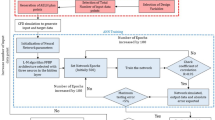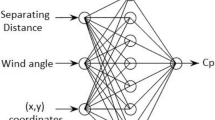Abstract
While experiments in boundary layer wind tunnels remain to be a major research tool in wind engineering and environmental aerodynamics, designing the modeling hardware required for a proper atmospheric boundary layer (ABL) simulation can be costly and time consuming. Hence, possibilities are sought to speed-up this process and make it more time-efficient. In this study, two artificial neural networks (ANNs) are developed to determine an optimal design of the Counihan hardware, i.e., castellated barrier wall, vortex generators, and surface roughness, in order to simulate the ABL flow developing above urban, suburban, and rural terrains, as previous ANN models were created for one terrain type only. A standard procedure is used in developing those two ANNs in order to further enhance best-practice possibilities rather than to improve existing ANN designing methodology. In total, experimental results obtained using 23 different hardware setups are used when creating ANNs. In those tests, basic barrier height, barrier castellation height, spacing density, and height of surface roughness elements are the parameters that were varied to create satisfactory ABL simulations. The first ANN was used for the estimation of mean wind velocity, turbulent Reynolds stress, turbulence intensity, and length scales, while the second one was used for the estimation of the power spectral density of velocity fluctuations. This extensive set of studied flow and turbulence parameters is unmatched in comparison to the previous relevant studies, as it includes here turbulence intensity and power spectral density of velocity fluctuations in all three directions, as well as the Reynolds stress profiles and turbulence length scales. Modeling results agree well with experiments for all terrain types, particularly in the lower ABL within the height range of the most engineering structures, while exhibiting sensitivity to abrupt changes and data scattering in profiles of wind-tunnel results. The proposed approach allows for quicker and more effective achieving targeted flow and turbulence features of the ABL wind-tunnel simulations as compared to the common trial and error procedures. This methodology is expected to enable wind-tunnel modelers a quick and time-efficient designing of ABL simulations in studies dealing with air pollutant dispersion, wind loading of structures, wind energy, and urban micrometeorology, where atmospheric flow and turbulence play a key role.












Similar content being viewed by others
References
Abdi D, Levine S, Bitsuamlak G (2009) Application of an artificial neural network model for boundary layer wind tunnel profile development. Proc 11th American Conf Wind Eng, San Juan, Puerto Rico
Alebić-Juretić A, Cvitaš T, Kezele N, Klasinc L, Pehnec G, Šorgo G (2007) Atmospheric particulate matter and ozone under heat-wave conditions: do they cause an increase of mortality in Croatia? Bull Environ Contam Toxicol 79:468–471
Anderson HR (2009) Air pollution and mortality: a history. Atmos Environ 43:142–152
Antonić O, Križan J, Marki A, Bukovec D (2001) Spatio-temporal interpolation of climatic variables over large region of complex terrain using neural networks. Ecol Model 138:255–263
Baklanov A, Grisogono B, Bornstein R, Mahrt L, Zilitinkevich S, Taylor P, Larsen S, Rotach M, Fernando HJS (2011) The nature, theory and modeling of atmospheric planetary boundary layers. Bull Am Meteorol Soc 92:123–128
Balendra T, Shah DA, Tey KL, Kong SK (2002) Evaluation of flow characteristics in the NUS-HDB wind tunnel. J Wind Eng Ind Aerodyn 90(6):675–688
Bishop C (1995) Neural Networks for Pattern Recognition. Oxford University Press, Oxford
Bitsuamlak G, Stathopoulos T, Bédard C (2006) Effects of upstream two-dimensional hills on design wind loads: a computational approach. Wind Struct 9(1):37–58
Bitsuamlak GT, Bédard C, Stathopoulos T (2007) Modeling the effect of topography on wind flow using a combined numerical–neural network approach. ASCE J Comput Civ Eng 21:384–392
Bottou LY (1998) Reconnaissance de la Parole par Reseaux Multi-Couches. Proceedings of the International Workshop on Neural Networks and Their Applications (NeuroNimes), 197–217
Brunskill AW, Lubitz WD (2012) A neural network shelter model for small wind turbine siting near single obstacles. Wind Struct 15(1):43–64
Chen Y, Kopp GA, Surry D (2003) Prediction of pressure coefficients on roofs of low buildings using artificial neural networks. J Wind Eng Ind Aerodyn 91:423–444
Cook NJ (1978) Determination of the model scale factor in wind-tunnel simulations of the adiabatic atmospheric boundary layer. J Wind Eng Ind Aerodyn 2:311–321
Counihan J (1969) An improved method of simulating an atmospheric boundary layer in a wind tunnel. Atmos Environ 3(2):197–214
Dyrbye C, Hansen SO (1997) Wind loads on structures. John Wiley & Sons, New York
English E, Fricke F (1999) The interference index and its prediction using a neural network analysis of wind-tunnel data. J Wind Eng Ind Aerodyn 83:567–575
Esau I (2010) On application of artificial neural network methods in large-eddy simulations with unresolved urban surfaces. Mod Appl Sci 4:3–11
ESDU 74031 (1974) Characteristics of atmospheric turbulence near the ground, Part II: single point data for strong winds (neutral atmosphere). Engineering Sciences Data Unit 74031
Fu JY, Li Q, Xie Z (2006) Prediction of wind loads on a large flat roof using fuzzy neural networks. Eng Struct 28:153–161
Fu JY, Liang SG, Li QS (2007) Prediction of wind-induced pressures on a large gymnasium roof using artificial neural networks. Comput Struct 85:179–192
Holmes JD (2007) Wind loading of structures. Taylor & Francis, UK
Huang P, Gu M (2005) Experimental study on wind-induced dynamic interference effects between two tall buildings. Wind Struct 8(3):147–161
Hucho WH (2002) Aerodynamik der stumpfen Körper. Vieweg & Sohn, Wiesbaden
Irwin HPAH (1981) The design of spires for wind simulation. J Wind Eng Ind Aerodyn 7:361–366
Kampa M, Castanas E (2008) Human health effects of air pollution. Environ Pollut 151:362–367
Khanduri AC, Bédard C, Stathopoulos T (1997) Modelling wind-induced interference effects using back propagation neural networks. J Wind Eng Ind Aerodyn 72:71–79
Kolmogorov AN (1941) The local structure of turbulence in incompressible viscous fluid for very large Reynolds numbers. Proc Acad Sci USSR 30:299–303
Kozmar H (2008) Influence of spacing between buildings on wind characteristics above rural and suburban areas. Wind Struct 11(5):413–426
Kozmar H (2010) Scale effects in wind tunnel modeling of an urban atmospheric boundary layer. Theor Appl Climatol 100(1–2):153–162
Kozmar H (2011a) Wind-tunnel simulations of the suburban ABL and comparison with international standards. Wind Struct 14:15–34
Kozmar H (2011b) Truncated vortex generators for part-depth wind-tunnel simulations of the atmospheric boundary layer flow. J Wind Eng Ind Aerodyn 99:130–136
Kozmar H (2011c) Characteristics of natural wind simulations in the TUM boundary layer wind tunnel. Theor Appl Climatol 106:95–104
Kozmar H (2012a) Physical modeling of complex airflows developing above rural terrains. Environ Fluid Mech 12:209–225
Kozmar H (2012b) Improved experimental simulation of wind characteristics around tall buildings. J Aerosp Eng 25:670–679
Kwatra N, Godbole PN, Krishna P (2002) Application of artificial neural network for determination of wind induced pressures on gable roof. Wind Struct 5(1):1–14
Mohorović L (2004) First two months of pregnancy—critical time for preterm delivery and low birthweight caused by adverse effects of coal combustion toxics. Early Hum Dev 80:115–123
Monks PS, Granier C, Fuzzi S, Stohl A, Williams ML et al (2009) Atmospheric composition change—global and regional air quality. Atmos Environ 43:5268–5350
Peterka JA, Hosoya N, Dodge S, Cochran L, Cermak JE (1998) Area average peak pressures in a gable roof vortex region. J Wind Eng Ind Aerodyn 77–78(1):205–215
Plate EJ (1982) Engineering Meteorology. Elsevier Scientific Publishing Company, Amsterdam, New York
Riedmiller M, Braun H (1993) A direct adaptive method for faster backpropagation learning: The RPROP Algorithm. Proc IEEE Int Conf Neural Networks
Schlichting H, Gersten K (1997) Grenzschicht-Theorie. Springer, Berlin
Sockel H (1984) Aerodynamik der Bauwerke. Vieweg & Sohn, Braunschweig
Sousa S, Martins F, Alvim-Ferraz M, Pereira M (2007) Multiple linear regression and artificial neural networks based on principal components to predict ozone concentrations. Environ Model Softw 22:97–103
Varshney K, Poddar K (2012) Prediction of wind properties in urban environments using artificial neural network. Theor Appl Climatol 107:579–590
Von Kármán T (1948) Progress in the statistical theory of turbulence. Proc Natl Acad Sci USA 34(11):530–539
Vujić B, Vukmirović S, Vujić G, Jović N, Jović G, Babić M (2010) Experimental and artificial neural network approach for forecasting of traffic air pollution in urban areas: the case of Subotica. Therm Sci 14:221–230
Wojciechowski M (2011) Feed-forward neural network for python. Dept Civ Eng Arch Env Eng, Technical University of Lodz, Poland, http://ffnet.sourceforge.net/
Xie ZN, Gu M (2005) A correlation-based analysis on wind-induced interference effects between two tall buildings. Wind Struct 8(3):163–178
Yasushi U, Tsuruishi R (2008) Wind load evaluation system for the design of roof cladding of spherical domes. J Wind Eng Ind Aerodyn 96:2054–2066
Acknowledgments
JK and GG acknowledge Mrs. Sanja Grgurić for her assistance and support, as well as the Gekom Ltd. Company. HK acknowledges support of the Croatian Ministry of Science and Technology, the German Academic Exchange Service (DAAD), and the Croatian Academy of Sciences and Arts (HAZU) for wind-tunnel testing at the Institute of Aerodynamics and Fluid Mechanics, Faculty of Mechanical Engineering, Technische Universität München; the helpful discussions with Prof. Boris Laschka, Dr. Albert Pernpeintner, and Dr. Joseph Fischer; and the TUM technical staff for the manufacturing of the simulation hardware, and in part the University of Zagreb grant 05206–2. BG acknowledges the Croatian Ministry and the Croatian National Science Foundation for support through projects BORA, 119-1193086-1311 and CATURBO, 09/151, respectively.
Author information
Authors and Affiliations
Corresponding author
Rights and permissions
About this article
Cite this article
Križan, J., Gašparac, G., Kozmar, H. et al. Designing laboratory wind simulations using artificial neural networks. Theor Appl Climatol 120, 723–736 (2015). https://doi.org/10.1007/s00704-014-1201-4
Received:
Accepted:
Published:
Issue Date:
DOI: https://doi.org/10.1007/s00704-014-1201-4




